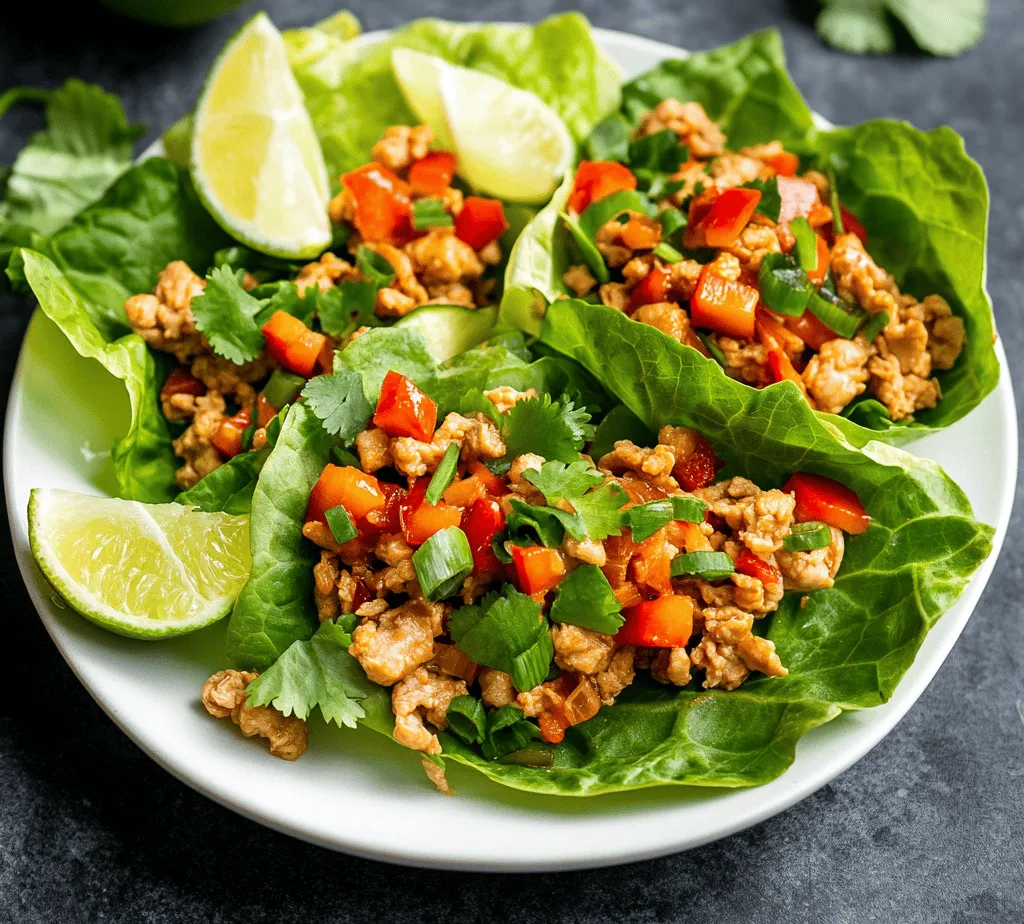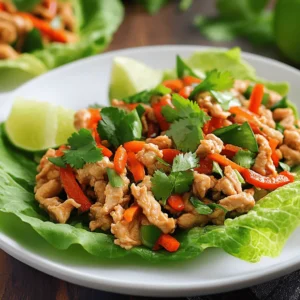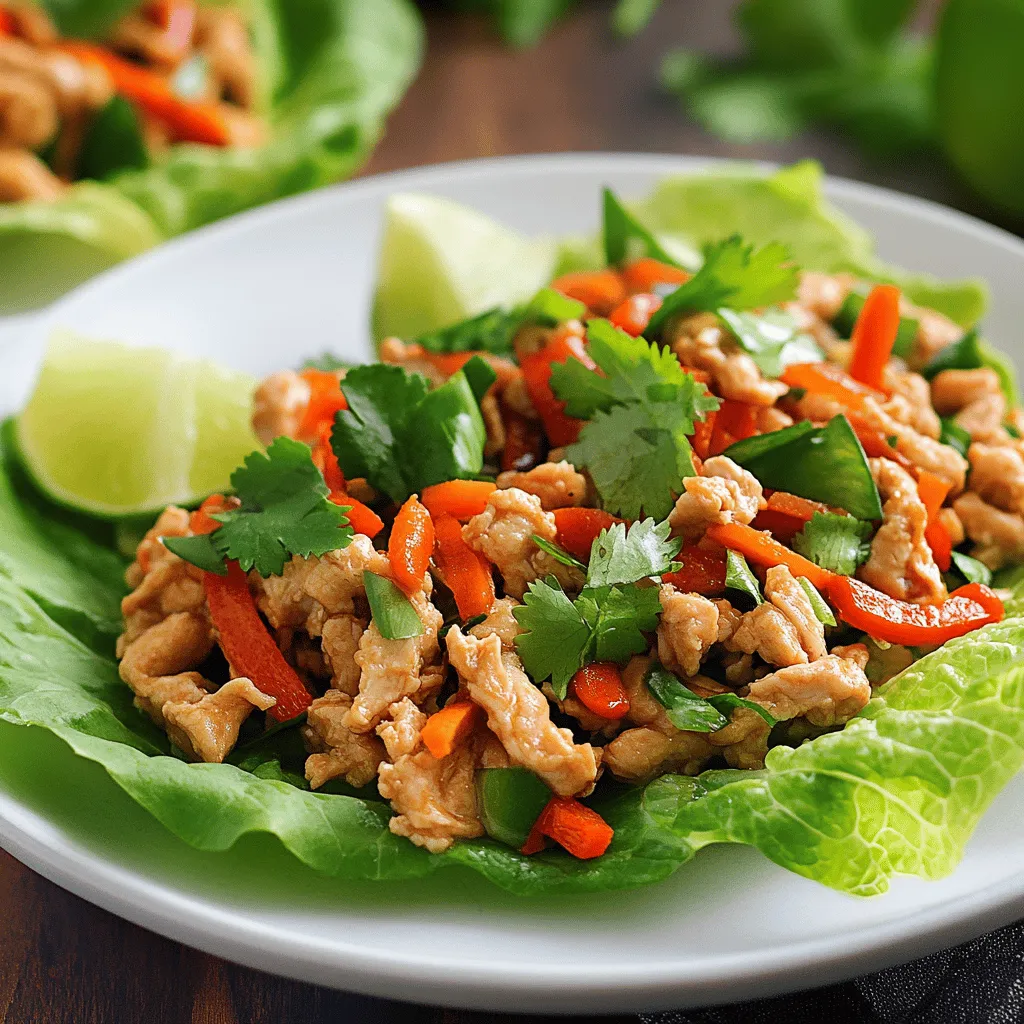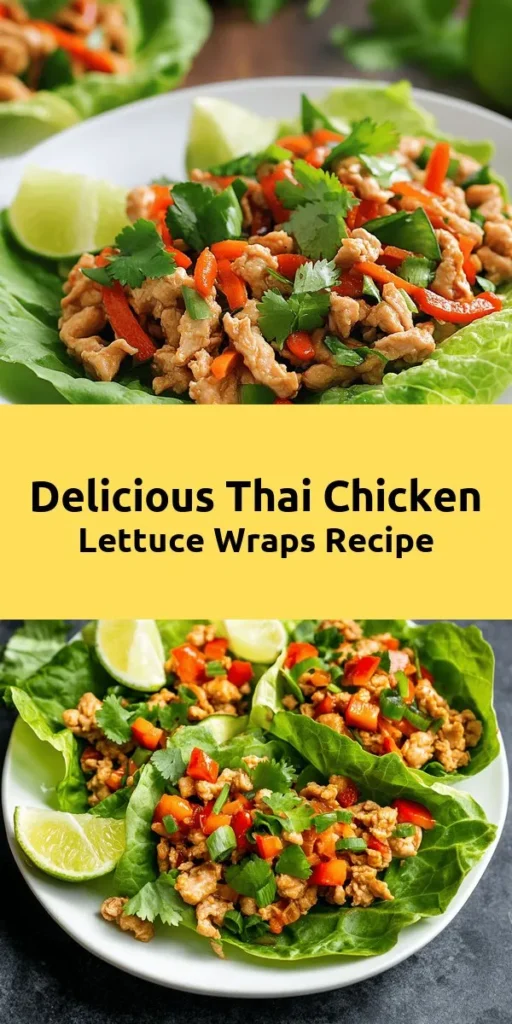Introduction
Thai cuisine is celebrated worldwide for its vibrant flavors, aromatic spices, and intricate balance of sweet, sour, salty, and spicy elements. From fragrant curries to refreshing salads, the culinary traditions of Thailand showcase a rich tapestry of ingredients and techniques that have captivated palates across the globe. One such delightful dish that exemplifies this harmony of flavors is Thai Chicken Lettuce Wraps, a popular choice among health-conscious diners and food enthusiasts alike.
These wraps are not only a delicious snack or appetizer, but they also offer a nutritious alternative to traditional heavier meals. Made with lean ground chicken and an assortment of fresh vegetables, Thai Chicken Lettuce Wraps are low in calories yet high in flavor. By utilizing crisp lettuce leaves as a wrap instead of bread or tortillas, you’re embracing a lighter, more refreshing way to enjoy your food. This dish is perfect for those looking to indulge in the bold flavors of Thai cuisine while keeping their meals light and healthy.
One of the most appealing aspects of Thai cooking is the emphasis on fresh ingredients. The quality and freshness of the components used can significantly enhance the overall taste of a dish. In the case of Thai Chicken Lettuce Wraps, the combination of ground chicken, vibrant vegetables, and aromatic herbs creates a symphony of flavors that tantalizes the taste buds. As we delve deeper into this recipe, you’ll discover the essential ingredients that make these wraps a must-try.
Understanding the Ingredients
To fully appreciate Thai Chicken Lettuce Wraps, it’s essential to understand the key ingredients that contribute to their unique flavor profile and health benefits. Let’s take a closer look at each component, starting with the star of the dish: ground chicken.
Ground Chicken
Ground chicken serves as the protein base for these wraps. It is a versatile ingredient that absorbs the flavors of the seasonings and sauces used in the dish. Not only is ground chicken lower in fat compared to beef or pork, but it is also an excellent source of lean protein, making it a healthier choice for those watching their diet. Additionally, its mild flavor allows it to pair well with various spices and sauces, making it ideal for this dish.
Fresh Vegetables: Red Bell Pepper, Carrots, and Water Chestnuts
The vegetables used in Thai Chicken Lettuce Wraps are just as crucial as the protein. Freshness is key, as it provides texture, color, and nutrients to the dish.
– Red Bell Pepper: Not only does it add a sweet, crunchy element to the filling, but it also brings a vibrant pop of color, making the wraps visually appealing. Red bell peppers are rich in vitamins A and C, contributing to overall health and wellness.
– Carrots: Shredded or finely chopped carrots provide a slight sweetness and additional crunch. They are also loaded with beta-carotene, which is beneficial for eye health and immune function.
– Water Chestnuts: These crunchy delights are often used in Asian cuisine for their unique texture. They add a satisfying crunch to the filling, making every bite enjoyable. Water chestnuts are low in calories and a good source of fiber, which can aid in digestion.
Flavor Enhancers: Soy Sauce, Fish Sauce, and Sriracha
To elevate the flavor of the chicken and vegetables, we turn to some essential sauces that are staples in Thai cooking.
– Soy Sauce: This umami-rich sauce adds depth and saltiness to the dish, enhancing the overall flavor profile. You can opt for low-sodium soy sauce for a healthier option.
– Fish Sauce: A quintessential ingredient in Thai cuisine, fish sauce brings a unique savory flavor that cannot be replicated. It adds complexity and is often used in dressings and marinades. While the smell may be strong, it mellows out during cooking, leaving behind a rich flavor.
– Sriracha: For those who enjoy a kick of heat, Sriracha sauce is the perfect addition. It adds spice and a hint of sweetness, balancing the savory flavors of the other ingredients.
The Role of Aromatics: Garlic and Ginger
Aromatics play a pivotal role in Thai cooking, and in this recipe, garlic and ginger are essential for building layers of flavor.
– Garlic: Known for its pungent aroma and robust flavor, garlic adds depth to the filling. It is also packed with health benefits, including anti-inflammatory properties and immune support.
– Ginger: With its zesty and slightly spicy profile, ginger enhances the flavor of the dish while providing a warmth that complements the other ingredients. It is also known for its digestive benefits and anti-inflammatory properties.
Health Benefits of Using Lettuce as a Wrap Instead of Traditional Bread
Using lettuce leaves as a wrap is not only a trendy choice but also a health-conscious one. Lettuce is low in calories and carbohydrates, making it an excellent alternative to traditional bread or tortillas. This swap allows you to enjoy the savory filling without the added calories and carbs, making it an ideal option for those on low-carb or gluten-free diets. Moreover, lettuce is rich in vitamins and minerals, contributing to a well-rounded meal.
Preparation Steps for Thai Chicken Lettuce Wraps
Now that we have a solid understanding of the key ingredients and their benefits, let’s move on to the preparation steps for crafting these delectable Thai Chicken Lettuce Wraps.
Preparing the Lettuce
Choosing the right type of lettuce is crucial for the success of this recipe. While various greens can be used, butter lettuce (also known as Bibb or Boston lettuce) is often preferred for its soft, pliable leaves that can easily cradle the filling. Iceberg lettuce can also work, but it is less flexible and may crack when folded.
– Step 1: Carefully separate the lettuce leaves from the head, taking care not to tear them. Aim for larger, intact leaves that can hold the filling without falling apart. Rinse the leaves under cold water to remove any dirt or impurities, then pat them dry with a paper towel. Set aside.
Cooking the Chicken
With the lettuce prepped, it’s time to focus on the main filling. Cooking the chicken properly is essential to achieve the right texture and flavor.
– Step 2: Heat a large skillet or wok over medium-high heat. Add a splash of oil—vegetable or peanut oil works well for this recipe. Once the oil is hot, add the ground chicken, breaking it apart with a spatula.
– Step 3: Cook the chicken for about 5-7 minutes, stirring occasionally, until it is browned and fully cooked. The key to achieving a perfect browning is to let the chicken sear without stirring too frequently; this allows it to develop a nice crust.
– Step 4: To ensure the chicken is thoroughly cooked, check that the internal temperature reaches 165°F (74°C). This can be done using a meat thermometer.
Incorporating Aromatics for Maximum Flavor
As the chicken nears completion, it’s time to infuse the dish with those essential aromatics.
– Step 5: Add minced garlic and grated ginger to the skillet. Sauté for about 30 seconds, or until fragrant, making sure not to burn the garlic, as it can turn bitter. This step is crucial for layering flavor in the filling.
Mixing in the Vegetables
Once the aromatics are aromatic and the chicken is cooked, it’s time to add in the vegetables.
– Step 6: Stir in the chopped red bell pepper, shredded carrots, and diced water chestnuts. Cook for an additional 2-3 minutes, allowing the vegetables to soften slightly while still maintaining their crunch. This balance of textures is key to an enjoyable wrap.
Creating the Flavor Profile
To finish off the filling, we need to incorporate the flavor enhancers.
– Step 7: Add soy sauce, fish sauce, and a drizzle of Sriracha to the skillet. Mix well, ensuring that the chicken and vegetables are evenly coated in the sauce. Allow the mixture to cook for another minute to combine the flavors.
– Step 8: Taste the filling and adjust the seasoning if necessary. If you prefer more heat, add additional Sriracha. If you want it saltier, a touch more soy sauce can enhance the flavor.
Achieving the Ideal Texture for the Filling
The texture of the filling is essential for a satisfying wrap. Aim for a mixture that is moist but not overly wet. If it feels too dry, a splash of water or chicken broth can help create a more cohesive filling. Conversely, if it’s too wet, allow it to cook for another minute or so to evaporate excess moisture.
With all these preparation steps in mind, you’re well on your way to creating these delicious Thai Chicken Lettuce Wraps. Stay tuned as we explore additional tips for perfecting this dish and answering some common questions about this beloved recipe!

Balancing the salty, sweet, and spicy elements in the sauce is crucial for the authentic flavor profile of Thai Chicken Lettuce Wraps. The sauce not only acts as a seasoning but also enhances the overall experience of the dish. A well-crafted sauce will harmonize the various flavors, creating a delightful contrast that takes your taste buds on an exciting journey.
To achieve this balance, consider using fish sauce for a savory umami flavor, soy sauce for depth and saltiness, and a touch of sugar or honey for sweetness. A squeeze of lime juice will add acidity and brightness, while fresh chilies or chili paste can introduce just the right amount of heat. Taste the sauce as you prepare it, adjusting each ingredient to suit your preference. This step is essential because letting the flavors meld together—ideally for at least 30 minutes—allows the ingredients to marry, resulting in a more cohesive and flavorful sauce.
Serving Suggestions
When it comes to assembling and serving your Thai Chicken Lettuce Wraps, presentation matters. Start by selecting the right lettuce. Butter lettuce or iceberg lettuce provides the perfect structure for holding the filling while offering a crisp bite. Lay out the lettuce leaves on a platter, and fill each leaf with a generous scoop of the chicken mixture, allowing for a bit of overflow for visual appeal.
To enhance the dining experience, consider providing a variety of toppings on the side, such as shredded carrots, chopped peanuts, cilantro, and sliced cucumbers. This allows guests to customize their wraps according to their preferences. For optimal enjoyment, encourage diners to use their hands to eat the wraps, as this not only makes for a fun eating experience but also adds to the authenticity of the dish.
Pairing suggestions for Thai Chicken Lettuce Wraps can elevate your meal. A refreshing cucumber salad with a tangy dressing complements the wraps beautifully. For beverages, consider serving a light Thai iced tea or a crisp white wine, such as Sauvignon Blanc, to balance the flavors of the dish. If you want to explore traditional Thai accompaniments, serve the wraps alongside a bowl of tom yum soup or a simple coconut curry for a complete meal.
Nutritional Information
Understanding the nutritional content of your Thai Chicken Lettuce Wraps helps you appreciate its health benefits. Each serving typically contains around 250-300 calories, depending on the quantity of chicken and sauce used. The dish is packed with protein from the chicken, fiber from the lettuce, and a host of vitamins from the vegetables.
Breaking down the contributions of individual ingredients, chicken breast is a great source of lean protein, which supports muscle growth and repair. Lettuce provides hydration and essential vitamins, particularly vitamin K, which plays a vital role in bone health. Peanuts add healthy fats and protein, while herbs like cilantro and mint offer antioxidants that combat inflammation.
This recipe can easily fit into various dietary lifestyles. It is naturally low in carbohydrates, making it suitable for those on a keto or low-carb diet. For gluten-free options, ensure that the soy sauce is gluten-free, or swap it with tamari. Additionally, for those looking to reduce meat consumption, these lettuce wraps can be adapted to fit vegetarian or vegan diets.
Cultural Significance of Lettuce Wraps in Thai Cuisine
Lettuce wraps hold a special place in Thai cuisine, reflecting the country’s culinary philosophy of balance and freshness. Historically, lettuce has been used as a vessel to carry flavorful fillings, making it a practical choice for street food vendors and home cooks alike. The use of fresh, raw ingredients emphasizes the importance of texture and flavor in Thai dishes.
In modern cuisine, Thai Chicken Lettuce Wraps have evolved, becoming a popular choice in both casual dining and upscale restaurants. This versatility showcases the adaptability of Thai flavors while appealing to a broader audience. When compared to other global variations of lettuce wraps, such as Korean ssam or Chinese mu shu, Thai wraps stand out with their vibrant flavor combinations and aromatic herbs.
Creative Variations of Thai Chicken Lettuce Wraps
While traditional chicken filling is delicious, exploring alternative proteins can add exciting twists to your Thai Chicken Lettuce Wraps. For a vegetarian option, consider using tofu marinated in the same sauce for a plant-based alternative. Shrimp can also be a delightful substitute, providing a seafood twist that complements the existing flavors.
For those seeking to accommodate a vegan diet, substitute the chicken with a mixture of sautéed mushrooms, bell peppers, and zucchini, seasoned with the same savory sauce. Additionally, consider adding unique toppings such as crushed nuts for crunch, fresh herbs like basil and mint for freshness, or even a drizzle of spicy sriracha for an extra kick.
Feel free to experiment with the fillings. Shredded carrots, bean sprouts, and chopped scallions can add color and texture. Incorporating avocado slices can provide creaminess and additional nutrients. The beauty of Thai Chicken Lettuce Wraps lies in their versatility, allowing you to adapt the recipe to suit your taste and dietary needs.
Conclusion
The versatility and appeal of Thai Chicken Lettuce Wraps make them a standout dish in any culinary repertoire. Their balance of flavors, combined with the freshness of the ingredients, creates a meal that is not only satisfying but also enjoyable to prepare and share with loved ones.
As you embark on your own cooking adventure, don’t hesitate to experiment with flavors and ingredients. Whether you stick with the classic recipe or explore creative variations, the joy of preparing these wraps lies in the ability to make them your own. Whether served as an appetizer or a main dish, Thai Chicken Lettuce Wraps promise to impress your guests and satisfy your cravings, all while celebrating the delightful essence of Thai cuisine.



